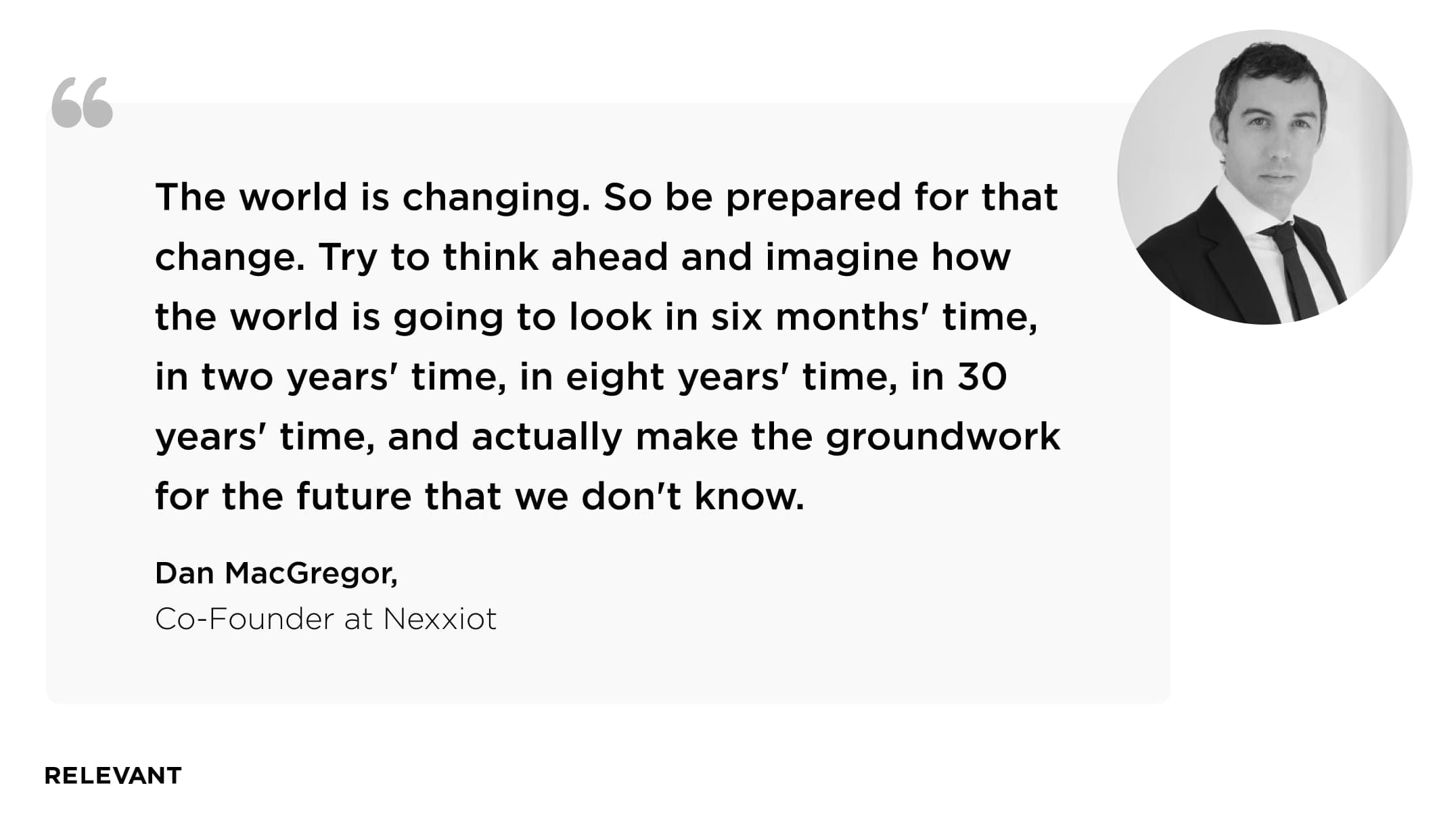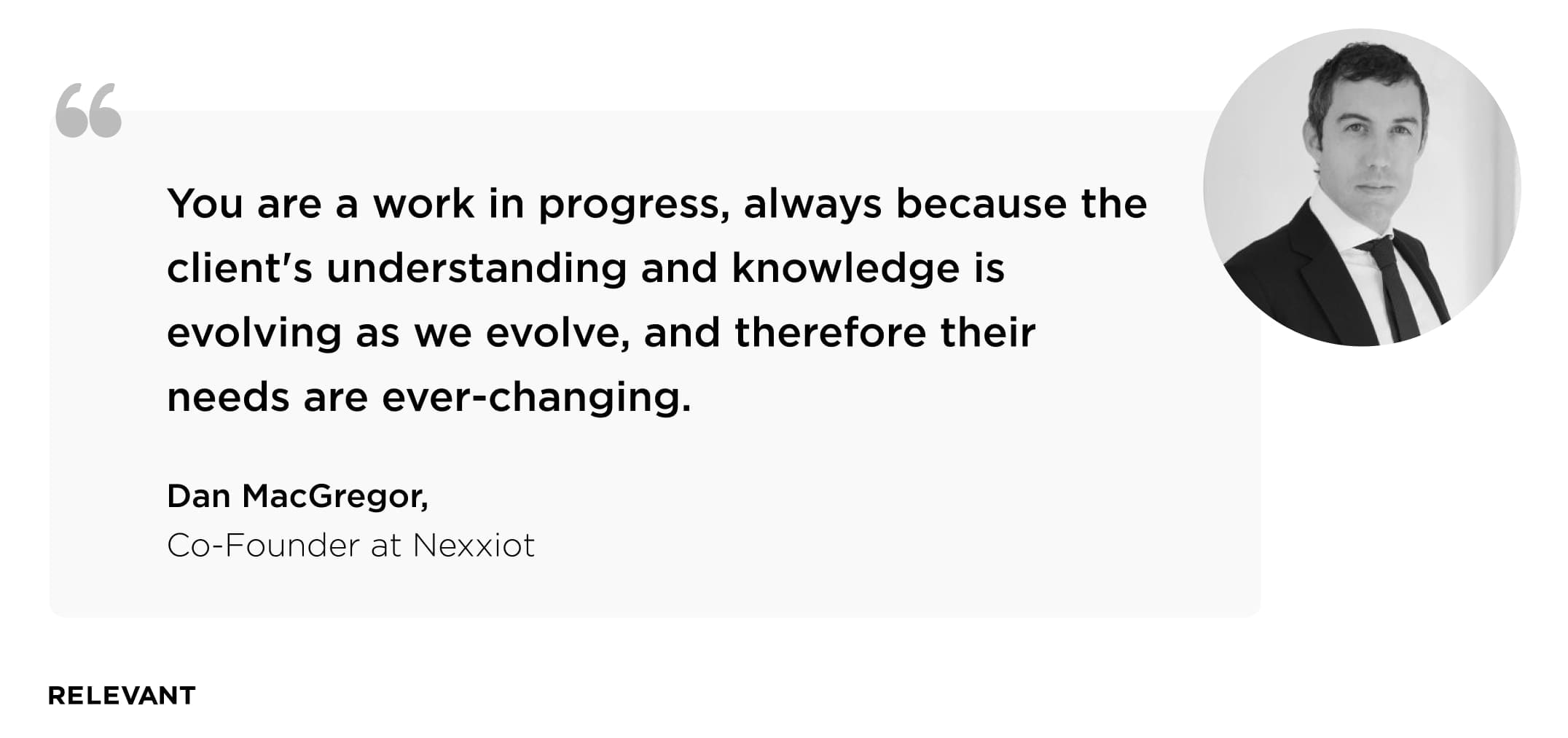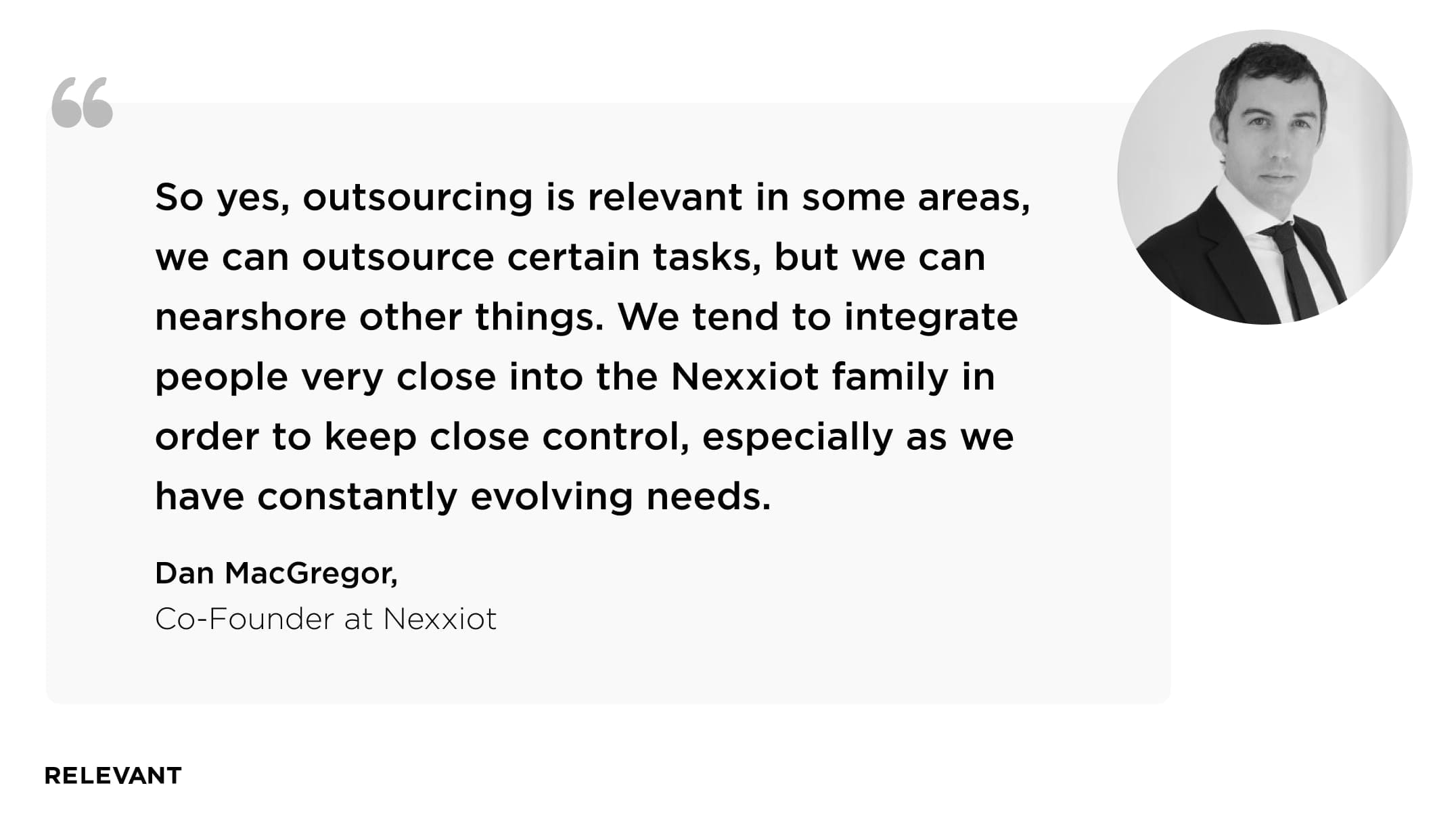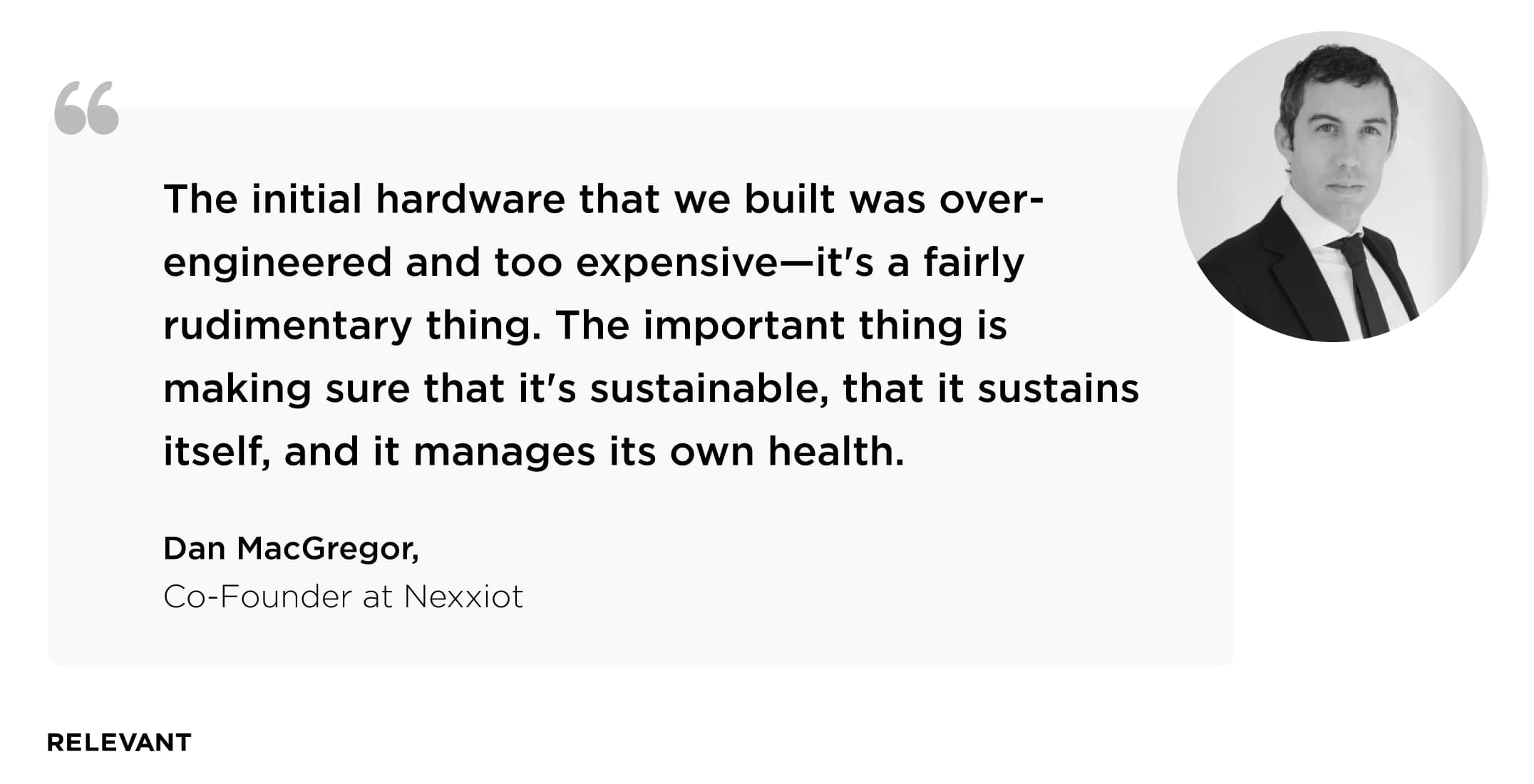The Making of Nexxiot — IoT and Big Data for Railcars & Tanktainers
Nexxiot, founded in 2015, is the independent enabler of the digitized supply chain that offers a complete IoT solution with sensors and software for data analysis. They leverage their expertise in industrial IoT to deliver unprecedented visibility to Rail Cargo supply chains and asset fleets, making efficient management as seamless and effortless as possible.
We sat down with Nexxiot Co-founder, Dan MacGregor, to talk about all things Nexxiot and the future of a digital supply chain in the wake of the IoT era.

We provide companies with senior tech talent and product development expertise to build world-class software. Let's talk about how we can help you.
Contact usWithin this article, Dan touches on the Nexxiot MVP and how pivots are essential for any startup; sharing how to make larger pivots into micro ones, what we can learn from Henry Ford, how to teach an old dog new tricks; convincing people there may be a more profitable way to do business and why, when building your company, you should leave your ego at the door.
Table of Contents
Hardware became uncool: The rise of Silicon Valley
Dan told us why, in order to understand the importance of Nexxiot and the hardware it is providing, it is important to go back to the beginning and note why hardware is the pillar to creating value from software.
15-20 years ago, Silicon Valley ceased making hardware and shifted its attention to start focusing on asset-light investments (app developments). The shift happened due to what Dan described as computing coming of age, with apps being the new way forward. He told us how he thinks the internet’s done very well at connecting humans to humans, but hardware still is and will continue to play its part.
“In the beginning, the first coders were sending code to impress their friends, and then email arrived, and then websites and shopfronts online, then moving into enterprise applications, like SAP or cloud-based software type products. But actually, I believe hardware is still bringing value to the software by providing unique data that are needed to offer digital services to different stakeholders.”

The importance of hardware to create value from software: Just look at Microsoft
GPS has been around for decades, yet there was no sure way to address the issue of tracking logistics and all of its data in real-time. Dan questioned why a digital supply chain solution wasn’t used extensively on mobile assets that are valuable and cargo that’s travelling around the world. Nexxiot was founded to solve this problem. It’s now essential to equip valuable assets and objects being moved from A to B with a piece of hardware that has the ability to track and report back in real-time all the data required.
“Silicon Valley grew up creating hardware. Microsoft, IBM, and these companies became legends in their fields because they created desktop computers, servers, and, in the case of IBM, infrastructure. Microsoft, then, sold those desktop computers to every university and school, every business, and every home. Moving on to sell Windows 1 through to 10 until everybody got bored and went straight to iOS. So, we use this as a precedent proving that there needs to be a hardware layer to create value from software.”
MVP: The development, the idea, and where the Nexxiot journey came from
“I looked at the world, and I was trying to think about the Internet of Things. You start with something that you perceive to be valuable, that is currently not monitored. I was always thinking about the supply chain because for me the value of the supply chain or the value in the supply chain is very intangible. We’re taking raw materials out of the grounds, such as coal or oil, grain for food, or forestry products for construction. No matter what we think, or no matter what we’d like to, how we like to portray the world to ourselves, we’re still reliant on those things in this capitalistic, postmodern world.”

Dan commented on the environmental situation and acknowledged that, while it’s a great notion to shut down oil and gas production and stop using plastics, there is currently no efficient and realistic way to do so without having disastrous consequences. We’re not there yet because it would result in incalculable numbers of deaths due to environmental harm. Investors want to demonstrate recurrent income and scalability, and there are 30 million shipping containers in the world, meaning that revenue is there to be taken.
Understanding the needs of the market: Think like Henry Ford
We spoke about the importance of getting ahead of the game and to start creating something which will be needed in the future, even if it seems ridiculous at this moment. Everything starts from one crazy little idea.
“The world is changing. So be prepared for that change. Try to think ahead and imagine how the world is going to look in six months’ time, in two years’ time, in eight years’ time, in 30 years’ time, and actually make the groundwork for the future that we don’t know,” Dan said.

Dan and the Nexxiot team told of the challenge of going to market and how the ‘ain’t broke, don’t fix it’ is rooted within our society. But what if there is a way to make the system far better, more economical, and profitable for all? Reminding us of the Henry Ford story—he asked the people what they wanted, and they said a faster horse. Dan explained how people can’t always imagine what they haven’t yet seen.
“People couldn’t imagine a metal chassis with combustion engine straps on and a braking system and a steering mechanism. So if we went to our customers in those early days and told them what’s not working in their supply chain, or what’s broken in their operations (maybe it’s a shipping line with a million or 2 million shipping containers) and they’d say, well, it’s working, everything’s fine, we’ve got everything we need.”
Ice age mentality: Reluctant to change
“This is our industry, it is just how it is. People are a little set in their ways when it comes to bringing in new processes. To bring something new and say maybe there’s another way to do this, for example, in terms of using data that would bring more value to your customers and to different stakeholders or even creating the chance for you to innovate and, either outpace your competitors or disrupt your competitors, with new business models. You need to know how to close the gap and know what’s needed and what you can provide.”

Dan adds that, on top of this, you have to also deal with the usual challenges of creating a startup: raising money, creating a brand, dealing with the growing pains, and the politics. Every startup understands the struggle of trying to manage a process that’s going at maximum speed with minimum resources.
Changing the old ways: How to convince stakeholders in the business to take a different approach and try something new?
“It is a bit of a numbers game. You have to find the right people with the appropriate culture and the right mindsets. You’ve got to find the challenges that they’re facing in their daily business and the things that they want to solve. It’s about asking the correct questions and also just building trust, and explaining to them what you’re thinking, such as how the process is going to work and where their weaknesses are, what are their concerns, and how you will make the product stronger, more reliable and more secure for them. You have to build a relationship.”
Challenges: The need to pivot
When you’re establishing a business, you’re always pivoting, especially in the first two years, at a breakneck rate. Dan believes that this is continual as you learn and then evolve. He tells us how It’s also a really intuitive approach and how you must be careful not to pivot for the sake of pivoting but for the right reasons; when you have qualified information in your hands. At Nexxiot they still continue to pivot but luckily due to their self-analysis and pivoting in the early days, they got themselves on a good track early, so there were only certain micro pivots.

“Before founding the company, we did a lot of our pivoting. Sometimes it was three pivots a day in the first two years. We came up with a theory, and I was making 100 phone calls a day to discover what the clients need and understand who our clients could be because, you know, you have all these different stakeholders through the global value network of the supply chain, and everybody could be a customer if you have unique data and value.”
Leave your ego at the door: Evolve just as your customers’ requirements do
“You have to leave your ego at the door at the very beginning of this process. Imagine you go to a meeting with the thing that you’ve worked on for two weeks or two months, but then you have an incredible discovery, or somebody criticises your idea, and you can do two things with that information. You can say, they don’t know what they’re talking about, we’ll keep going, or you can integrate that new information into your product, and you can pivot as a result.
Dan tells us how you should be flexible and not fixated on a specific outcome, but to push a positive trend.
“You are a work in progress, always because the client’s understanding and knowledge is evolving as we evolve, and therefore their needs are ever-changing.”

The simplicity of tracking: Is it so simple?
Dan discussed how supply chain logistics lacks the level of visibility that we experience in many aspects of our day-to-day lives. We can track everything else by the click of a button: we can monitor our pets in the garden, our child on the way to school, our luggage through the airports, our new shoes, through the mail to our front door, but we can’t always effectively monitor a shipping container full of iPhones across the planet.
“When you start to unpack that, you realize the complexity of it. The first complexity is the device hardware, as it needs to still stay self-sustained, be self-healing, and the other is power management. I realised that I wanted to equip these shipping containers and do something that’s scalable, and impactful. So, we had to ask ourselves, well, what’s similar to a rail to a shipping container, but it’s got moving parts. And it turns out that a rail car is around $50,000, or euros to buy, it’s got lots of moving parts, and it needs to be optimized. So, we flipped to rail to continue gaining experience and to win customers, keeping us in the game.”
Managing a distributed team: Hire purpose-driven specialists
A question we always put to our guests on the show is one dedicated toward managing a team, especially a distributed one, full of not only different personalities and cultures, but also the difficulty in managing a team when you are all working in different time zones. It is one of the issues always raised when businesses look to outsource their team or hire from the pool of talent across the globe. Dan, however, doesn’t see this as a challenge and believes at Nexxiot, people are rather self-managing.
“You can be fairly bottom-up in terms of the management, and everybody is fascinated by their own individual task. They’re working together in many squads with others that they like and care about. So in that sense, it’s quite self-managing. Everyone’s extremely motivated and prepared to go the extra mile and purpose-driven.”

“We’ve got this incredible team here. Super nimble, super agile, incredibly committed. We have 100 people, we’ve got 30 nationalities. We all have our own joining story. We have made it their business to understand what our customers need, and to develop the products around that. So yes, outsourcing is relevant in some areas, we can outsource certain tasks, but we can nearshore other things. We tend to integrate people very close into the Nexxiot family in order to keep close control, especially as we have constantly evolving needs.”

Building the hardware device
“My co-founder, was a brilliant technician and extremely innovative in putting things together. He put together the rudiments of this device, enough to test it and to start communicating it to potential partners, so it could be built more professionally.”
“The truth is that it was hacked together from existing components. The initial hardware that we built was over-engineered and too expensive—it’s a fairly rudimentary thing. The important thing is making sure that it’s sustainable, that it sustains itself, and it manages its own health.”

“We’ve probably had 350 versions of the hardware. The first 150 were still hacked together and 3D printed in-house. But then, once you start to get it into a stable form factor, and stable design, then you want to try to consolidate your components and your bill of materials because this is a risk.”
“We had some great nerds on board, right from the beginning, who loved making hardware, and we still do—they’re fascinated by it. They constantly need a challenge to keep them interested and to capture their imaginations.”
Our core services:
Do you want a price estimate for your project?
Do you know that we helped 200+ companies build web/mobile apps and scale dev teams?
Let's talk about your engineering needs.
Write to us












